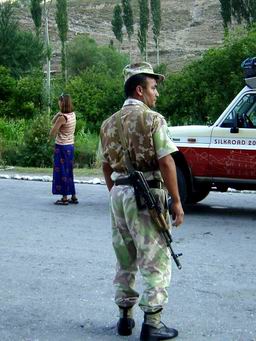
Border nerves
We leave Kyrgyzstan with heavy hearts where the friendly people will stay in our memories for a long time and the liberal atmosphere of change in the land we find remarkable. Even the policeman whose laser gun we go way too fast for lets us go with a warning, handshake and a smile.
This kind of pleasant atmosphere to travel by is suddenly gone at the border to Uzbekistan. Our initial try to drive the historical route from Osh to Fergana is over at the border checkpoint. Pedestrians can only the border crossing at this location. These two former Soviet Republics regard themselves as independent states since 1991. We then drive back to Osh and succeed the second time to get into Andijan. Departing Kyrgyzstan is promptly settled. They even forget to stamp our passports with exit stamps, which will help us immensely in our later travels where we continually change from state to state.
Our arrival in Uzbekistan has the charm of an ex-GDR transit control point. First we have to drive through a disinfectioning basin. Then we are inspected with a uranium detector, as uranium is being widely smuggled, and last but not least we are snuffled by a drowsy drug hound. It is here that we learn the meaning of the word „registrazia„. This will be accompanying our every footstep through Uzbekistan. At every border, at various control points and on almost every street corner stands a uniformed official who more or less intricately takes down our passport and vehicle information in a big thick book. This takes costly time and nerves! At every diverse control point these control official must think that we are Santa Claus. Sometimes they ask about Ute' s sunglasses or our watches or ask right out for a few dollars to sweeten their salary. We remain friendly, speak only German and don' t let them know that we understand what they are talking about. It helps too, with many gestures, to report about our travel route, our families and our many children at home or when nothing else helps to hold up an out of date credit card when the questions come about our finances. Up until now we' ve been lucky and the officials give up.
 Border nerves |
A particular highlight about going over the border is the customs forms in the Russian language. After the border official very severely demands that we fill out the customs forms in Russian without any help we eventually fill them out with information in a completely ridiculous English. Even he gives up after a while and grabs for a pencil. After payable currency and traveler' s checks „coincidently„ land under his newspaper, this marks the start of a series of the game hide and go seek.
And because we still want to reach the wonderful Uzbekistan area of Shohimardon today, we go through seven border controls in all at Kyrgyzstan and Uzbekistan checkpoints. Each time with „registrazia.„ And so in this way we gather enough experience and learn to perfection how to deal with Uzbekistan soldiers and policemen.
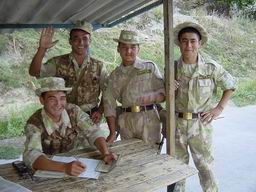 Sometimes friendly „registrazia„ |
In Shohimardon we are compensated with a very beautiful mountain landscape. Unfortunately, as elsewhere in Ferghana Valley, now and again there are attacks by armed Islamic guerrillas. Because of land mines the army recommends that we cancel our trek in the mountains.
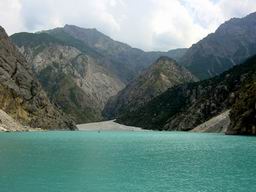 Beautiful Shohimardon |
After a short stay in the mountain village of Sharkhimardan we will continue our route along the Silk Road through the Fergana Valley. The agricultural economy is booming as can be seen from the many provisional stalls selling goods along the road. The tomatoes here taste like something our poor supermarket-tortured taste buds have never experienced. Gradually the ecologically unsound cotton mono-agriculture is making way for a variety of fruits, vegetables, and grains.
 Cotton fields |
We travel through the very green city of Fergana and spend the night in Kokand on the way west. One notices that everywhere in the country the „achievements„ of the Soviet Union era are gradually being shaken off. The supermarket has been closed long ago: Traditionally the bazaar is where the people went to buy and sell, and in the isolated Fergana Valley the old customs are being returned to more rapidly than elsewhere.
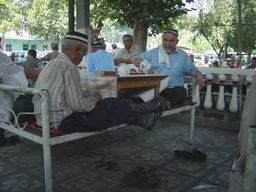 Street Life in Kokand |
We have to go through a small pass and a few burdensome checkpoints to leave Fergana Valley and head toward Tashkent, the capital of Uzbekistan, to settle a few organizational things. Traveler' s checks, it seems, can only be exchanged against the country' s currency of Sum and to our great amazement we receive a pile of bills twenty centimeters thick for a few hundred US dollars. They even give us large denomination bills or our backpack would have been too small for transporting the money.
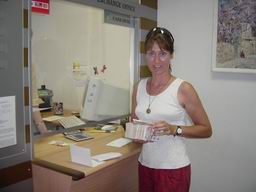 Inflation |
As soon as we have our visas for Turkmenistan in our passports we make a fast exit. The ratio of police per square meter in this city clearly excels our threshold of tolerance. One immediately realizes that even today Uzbekistan is ruled as a totalitarian regime by the model communist president Karimow and is seen as a „communist preserve„ amongst the CIS.
The hoped for historical sights of the Silk Road, even with the help of a guide, are hard to find. After the earthquake of 1966 the Soviet Central Committee took the opportunity to change the face of Tashkent into the well-known monumental East Block architectural style even though the damage in the old city was limited. Today cold, distancing buildings dominate the city landscape.
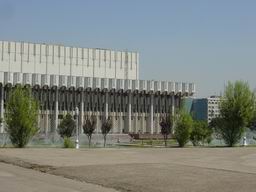 Modern Tashkent |
Those who wish to experience the history, art and culture of the Silk Road in Uzbekistan should go to Samarkand, Bukhara and Chiva anyway, and we can' t wait to get to these cities.
„The Golden City, Paradise of the East, the Rome of Central Asia„ - these are only a few of the names that the city of Samarkand has earned in history. At first glance today' s reality looks very different which is proven by observing the look-alike housing blocks and factories at the edge of the city. Only in the old inner city do we find a small part of the Samarkand that we always had in our imaginations. Unfortunately the old city walls, gates and old crooked alleyways were sacrificed for the new architectural reformation. So we decide to go along on the usual sight-seeing tours and take in the Registan Square, the gaudy plaza of the world ruler Timur (1336-1405). Originally the Registan Square was nothing other than a market place where everyday Oriental life took place. It was here where public executions were held before the eyes of the curious, where parades took place and public law declarations were announced. Later on in history the world famous and well-known Madrasah, consisting of three buildings, were built here at right angles around the square. In these theological universities students learned the Koran along with the natural sciences in narrow cells.
 Registan Square |
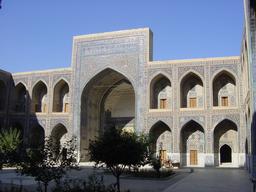 Madrasah on Registan Square |
According to our observations Timur is omnipresent: After destroying the city, Genghis Khan spared no expense to make Samarkand a world metropolis. Never before were buildings of such beauty, stature and complexity erected.
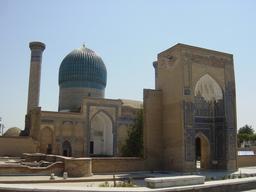 The mausoleum of Timur |
In the meantime we can very well imagine how important Samarkand was as an axis for trade and culture on the Silk Road. In this way it guided the route from here through Merv, Persia, and Turkey to the Mediterranean Sea. The other route curved towards the south, crossing the passes of the Hindukush to India. After this excursion we will be going north to Chiva, a beautiful desert city. The route guides us 400 kilometers along the Amu Darya River that lies between the deserts of Karakum and Kyzylkum. The water of the Amu Darya has been used intensively for the irrigation of the mono-agricultural cotton plantations, which have contributed a great deal to the Aral Sea in the north drying up.
 Destination Chiva |
Finally we find a city in Chiva that comes close to our idea of what a city in the „1001 Arabian Nights„ would look like. Three hundred people still live behind the fortress walls in clay houses in the old inner town of Itchan-Kala. In no other city in Central Asia do we find so many authentic and undamaged monuments so that we experience in Chiva an example of a medieval, Islamic city that still preserves this flair in day-to-day life. Almost fifty Islamic universities (madrasas) are witness to an era when religion and science were analogous. However, Chiva was also the center of the slave trade in Central Asia. Slaves from Asia, Africa and Europe awaited their auction on the Great Slave Market at the western gate of the city wall.
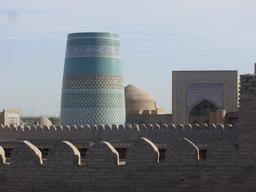 View of Chiwa |
 The old town |
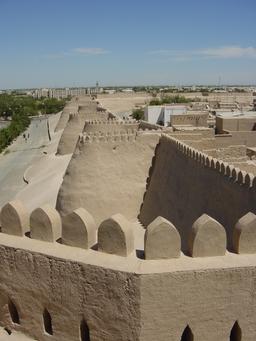 The city wall |
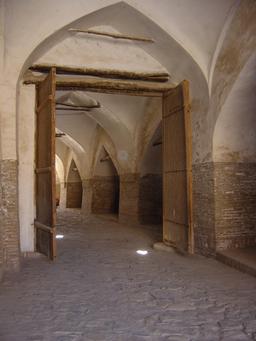 The slave market |
The well-preserved palace shows us what life must have been like then. It consists of many areas and interpolated inner courtyards - the great hall, the court of justice, and the harem - all surrounded by a high wall. All over are Chiva-typical wood carvings and glazed tile ornaments. The great inner courtyard was reserved for the harem where the rooms of the Khan and his women were situated. Women and children of all nations lived here shut away and guarded by eunuchs until the last emir fled in the year 1920.
 The courtyard of the harem in the palace |
 Typical ornaments |
We continue our journey to the south - back to Bukhara - out last station in Uzbekistan.
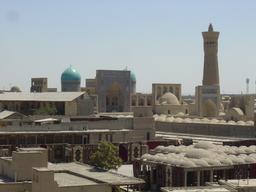 The view of Bukhara |
In Europe we know Bukhara mostly from tales and Oriental writings. Bukhara is a city of mosques, madrasas and artistic handicrafts with an old inner town that is immediately likeable. Many of the artistic workshops create iron utensils or the well-known carpets with interwoven gold threads. We spontaneously decide to get curtains for our land cruiser embroidered with the Kalan Minaret, the emblem of Bukhara, in gold thread.
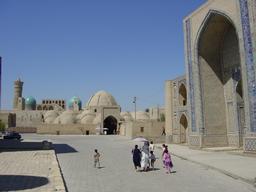 Domed bazaar |
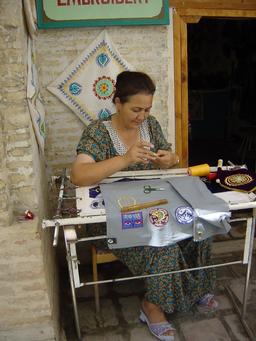 Embroidery |
This fifty meter high Minaret served as an execution place for those sentenced to death way into the 20th century. As execution, the convicted was put into a sack, brought up to the top of the Minaret and then thrown off. One can hardly believe the barbarous ways of yesteryear looking up at the glorious Minaret today. Bukhara was inaccessible to foreigners up to 150 years ago. The consequence to intrusion was death. Only a few business people, diplomats, and English „scouts„ lived to tell about it. Others were thrown from the Minaret, died at the stake or ended in the Zidan, a black hole where the emir left his victims to a particular kind of flesh eating parasite. The open canalization is the Zidan of today. Those who aren' t constantly looking down have the danger of disappearing in the city sewers. This danger by the way isn' t restricted to Bukhara but has followed us since we were in China.
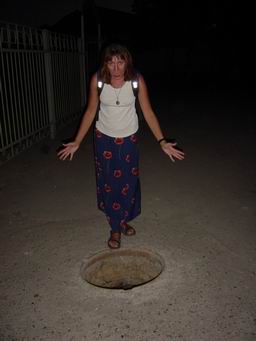 Caution: sewer |
Full of ancient cultural impressions we leave Bukhara and follow the Silk Road westward to Turkmenistan. New land, new luck.